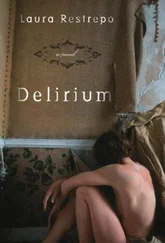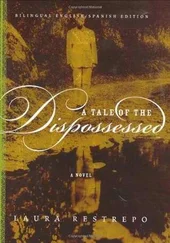“Claire wasn’t a sad woman,” says Todos los Santos in an elegiac tone, “she was sadness itself disguised as a woman. I have never known a more helpless soul in all the days of my life. However, it was she who brought to our attention that in the France of the Louis we, the courtesans, triumphed and we proudly let ourselves be called daughters of happiness.”
I always imagined this beautifully surreal scene: a group of women wrapped in black clothes yet immune to the suffocating and shadowless midday heat, standing in front of a fresh hole in the red dirt of Tora in the middle of a vast nothingness of high pastures. A couple dozen Cebu cattle with several herons perched on their backs watching with infantile curiosity and slowly forming a circle around the field’s unusual visitors.
Months later, when I myself had to attend a burial in the same place and under similar circumstances, I was able to verify that there in fact was a heat that was unbearable for me, tolerable for them, and the cattle also were there with their tick-removing herons, and the dead woman who yields docilely to the red earth. And yet, the foreshadowed image contained a double error that I will correct at once: There was shade after all, because the grave had been dug beneath the shelter of an enormous violet guayacán tree in full bloom, and the women weren’t standing, solemn but at the same time eager to leave that place, as is often the case with the mourners in the Jardines del Recuerdo, the Tierra del Apogeo, the Valle de la Paz, and the rest of the cemeteries in our cities; instead they were idle and lying down in a clearing with the patience of rocks, as placid as if they had come to stay, chatting among themselves openly about the deceased’s virtues, about her bad habits, about the illness that led her to the grave, about anything in general and in particular, and about the chicken stew that they were going to cook right there and consume with rum in complicity with the traveler to the next world and as a means of invoking her well-being.
As the stew was eaten and beautiful Claire was remembered, and afterward too, during the shoveling of dirt on the coffin, Todos los Santos looked from time to time toward the path leading to the pueblo with a presentiment of her adopted daughter Sayonara’s arrival, which nevertheless didn’t occur then or later, while they waited at home until after eleven that night without receiving word that she was at the Dancing Miramar, the neighborhood cafés, the home of one of her friends, the rocks at the river with the laundresses, the Arab’s shops, the Acandai waterfall, or other usual places; they grew so worried that toward midnight Todos los Santos, Olga, and Machuca went looking for her at the hospital, the police station, and finally the morgue, but all without result.
“She isn’t injured, sick, or dead,” concluded Todos los Santos, who refused to keep looking for the girl and ordered the others to go to bed. “She left because she wanted to.”
Why had Sayonara left? It wasn’t easy to deduce the motive for her fleeing, which had occurred just when her life was going splendidly. She had become a golden legend, surrounded by the love of hundreds of petroleros, possessed of radiant youth and a wild beauty that was magnified a hundredfold by rumors. Loved and supported by her madrina, who was an imposing figure in La Catunga, and by the majority of the population of the barrio, who accepted without jealousy her clear professional supremacy. She was privileged also in the art of being a puta , in having so many aspirants that she could give herself the luxury of rejecting drunks, foul-smelling or virus-pocked clients, men with sour characters or exotic tastes in bed; she was so spoiled and blessed among all the other women that she only needed to appear briefly in the Dancing Miramar and to dance under the spotlights, somnolent and unenthusiastic, for the men who were in love with her to express their willingness to give her their paychecks just to caress her with a look.
The day after Sayonara’s disappearance, Olguita, Delia Ramos, and the others devoted themselves to figuring what had happened to her and to finding her no matter where she was, and through inquiries and interrogations they managed to follow her trail to a tiny river port an hour and a half from Tora called Madre de Dios, where some fishermen confirmed they had seen her arrive alone, walking without bags and barefoot. Beyond Madre de Dios, all trace of her vanished.
“Maybe she boarded a chalupa and went downriver,” said the fishermen without conviction. “Maybe, who knows?”
Isolated in her house, a perplexed and shaken Todos los Santos locked herself in her room and lit three candles of supplication on her altar.
“Tell me where she is, Jesucristo,” she begged. “If you don’t know, no one knows.”
The Holy Christ smiled at her as pained as always, sweet and removed from human affairs, never uttering a word.
Then Todos los Santos began to study the postcards, remembering the faith with which Sayonara seemed to seek in them the key to some divine plan.
“Would she have gone off to look for Sacramento?” she asked herself, and the possibility seemed soothing to her, because it meant that the web of affection that they had woven together had not been broken, and that the girl wasn’t wandering around lost, as feared, through the distant, unreachable shadows of her past. But no, it wasn’t likely that she had followed after Sacramento, because the postcards gave no account of the location from which they had been sent.
Two things had occurred on the previous ill-fated day, mused Todos los Santos, wanting to tie up loose ends as she carefully examined the postcards to extract their secrets from them. Claire’s death and Sayonara’s disappearance: What did these two adversities have to do with this PALACE IN KATMANDU, opening its gardens to visitors, or with these two women, so absorbed in knitting their lace that to them the rest of the world doesn’t exist? What the devil could be revealed by this QUEEN ELIZABETH II OF GREAT BRITAIN, if she seemed to be asleep with her eyes open beneath the weight of her enormous crown? What hidden thread could unite the FUNERAL URN, MUISCA CULTURE with the PORCELAIN JAR, MING DYNASTY, NINETEENTH CENTURY? Nothing, absolutely nothing, aside from the fact that both were thousand-year-old earthenware vessels. And so she continued to speculate, trying to make some sense of this nonsense, dazed with confusion, until dawn arrived, then she spent two days eating little and speaking even less, ruminating senselessly on the words on the postcards until she pushed them aside in disgust.
“No more silliness,” she ordered herself. “We only know what our hearts tell us about people, and mine is shouting to me that this girl is going to come back. I just have to give her time.”
With the first light of the fifth day, Todos los Santos, still not completely awake, saw Sayonara again. Or thought she saw the girl standing at the threshold of her vigil, there at her bedroom door. But she was shrunken, thin, and timid, just as she had appeared two years before when she arrived in Tora for the first time. The spectral apparition looked at her without smiling, once again looking more like a child than an adolescent, once again malnourished, suspicious, barefoot, and unkempt — smelling, as before, of smoke and helplessness. As if time had stagnated and everything were unreal and identical to the way it had begun.
“Are you a person or a memory?” whispered Todos los Santos.
Todos los Santos was on the verge of collapse when she was rescued by another sudden apparition in the doorway. This time it was the real Sayonara, the same smiling, beautiful girl who had left the house on the day of Claire’s death.
Читать дальше












